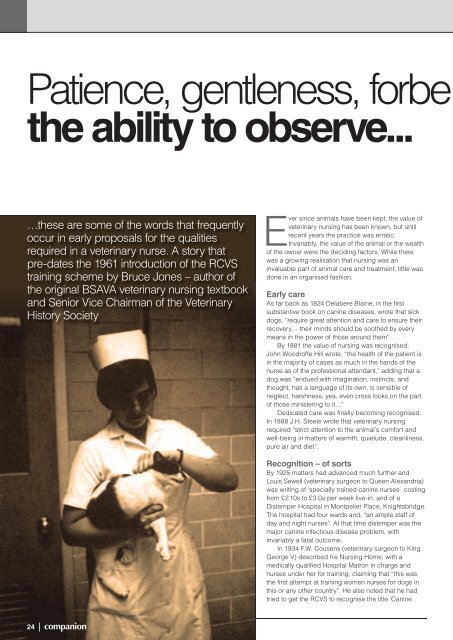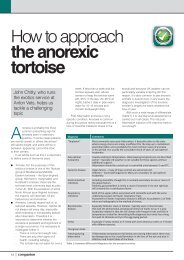Companion May 2012 - BSAVA
Companion May 2012 - BSAVA
Companion May 2012 - BSAVA
Create successful ePaper yourself
Turn your PDF publications into a flip-book with our unique Google optimized e-Paper software.
Patience, gentleness, forbe a<br />
the ability to observe...<br />
…these are some of the words that frequently<br />
occur in early proposals for the qualities<br />
required in a veterinary nurse. A story that<br />
pre-dates the 1961 introduction of the RCVS<br />
training scheme by Bruce Jones – author of<br />
the original <strong>BSAVA</strong> veterinary nursing textbook<br />
and Senior Vice Chairman of the Veterinary<br />
History Society<br />
24 | companion<br />
Ever since animals have been kept, the value of<br />
veterinary nursing has been known, but until<br />
recent years the practice was erratic.<br />
Invariably, the value of the animal or the wealth<br />
of the owner were the deciding factors. While there<br />
was a growing realisation that nursing was an<br />
invaluable part of animal care and treatment, little was<br />
done in an organised fashion.<br />
Early care<br />
As far back as 1824 Delabere Blaine, in the first<br />
substantive book on canine diseases, wrote that sick<br />
dogs, “require great attention and care to ensure their<br />
recovery… their minds should be soothed by every<br />
means in the power of those around them”.<br />
By 1881 the value of nursing was recognised.<br />
John Woodroffe Hill wrote, “the health of the patient is<br />
in the majority of cases as much in the hands of the<br />
nurse as of the professional attendant,” adding that a<br />
dog was “endued with imagination, instincts, and<br />
thought, has a language of its own, is sensible of<br />
neglect, harshness, yea, even cross looks on the part<br />
of those ministering to it…”<br />
Dedicated care was finally becoming recognised.<br />
In 1888 J.H. Steele wrote that veterinary nursing<br />
required “strict attention to the animal’s comfort and<br />
well-being in matters of warmth, quietude, cleanliness,<br />
pure air and diet”.<br />
Recognition – of sorts<br />
By 1925 matters had advanced much further and<br />
Louis Sewell (veterinary surgeon to Queen Alexandria)<br />
was writing of ‘specially trained canine nurses’, costing<br />
from £2.10s to £3.0s per week live-in, and of a<br />
Distemper Hospital in Montpelier Place, Knightsbridge.<br />
The hospital had four wards and, “an ample staff of<br />
day and night nurses”. At that time distemper was the<br />
major canine infectious disease problem, with<br />
invariably a fatal outcome.<br />
In 1934 F.W. Cousens (veterinary surgeon to King<br />
George V) described his Nursing Home, with a<br />
medically qualified Hospital Matron in charge and<br />
nurses under her for training, claiming that “this was<br />
the first attempt at training women nurses for dogs in<br />
this or any other country”. He also noted that he had<br />
tried to get the RCVS to recognise the title ‘Canine



